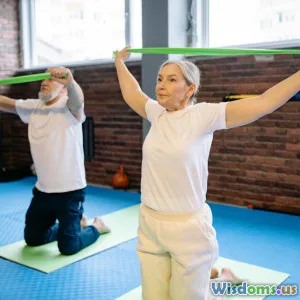
Can Older Adults Really Build Muscle Like the Young
8 min read Exploring how older adults can effectively build muscle and improve strength, rivaling youthful gains through science-backed methods and inspiring real-life examples. (0 Reviews)
Can Older Adults Really Build Muscle Like the Young?
Aging brings many changes, but must muscle building be one of its unavoidable declines? While youth is often associated with peak physical performance and rapid muscular gains, recent science and inspiring stories tell a different tale. This article examines whether older adults can truly build muscle comparable to younger individuals — and how they can do it safely and effectively.
Understanding Muscle Loss and Aging
What Happens to Muscle as We Age?
A natural biological process called sarcopenia causes progressive muscle loss as we grow older, typically starting around age 30 and accelerating after 60. According to research published in the Journal of Cachexia, Sarcopenia and Muscle, adults can lose 3% to 8% of muscle mass per decade without intervention. This loss affects strength, balance, and overall physical function.
Several factors contribute to this decline, including hormonal shifts (like decreased testosterone and growth hormone), reduced physical activity, changes in protein metabolism, and neurological alterations affecting muscle activation.
Does This Mean Muscle Gain Is Impossible?
Not at all. The decline indicates baseline muscle mass reduction but doesn’t negate the body’s ability to adapt and grow stronger.
Dr. William J. Evans, professor at the University of Texas Medical Branch, emphasizes, “Older adults retain significant capacity for muscle hypertrophy and strength gains.” Studies show that even people in their 70s and 80s can gain muscle mass and improve functional strength with proper training.
Scientific Evidence: Muscle Hypertrophy in Older Adults
Resistance Training Research
The cornerstone of evidence supporting muscle growth in older adults is the extensive research on resistance training (weightlifting or strength training).
A landmark 2011 study by Reid et al., published in Medicine & Science in Sports & Exercise, showed men aged 60+ increased muscle size by 10% after 12 weeks of consistent resistance training. Remarkably, strength improvements were comparable to those seen in younger populations over similar training periods.
Similarly, research from the University of Copenhagen demonstrated that older adults who performed progressive resistance exercises three times per week gained significant muscle cross-sectional area and strength. Notably, gains occurred even in individuals with previously low physical activity levels.
Molecular Adaptations
Studies have found that muscle cells in older adults still respond to exercise-induced signals that promote protein synthesis — essential for muscle building. Although the rate may be slower compared to younger people, the capacity is intact.
A publication in The Journals of Gerontology detailed how type II (fast-twitch) muscle fibers, which typically atrophy with aging, respond well to heavy resistance exercise by regaining size and strength.
Real-Life Examples That Inspire
1. Ernestine Shepherd: The Oldest Female Bodybuilder
At over 80 years old, Ernestine Shepherd is recognized by the Guinness World Records as the oldest competitive female bodybuilder. Starting her fitness journey at 56, her dedication proves that age is no barrier to dramatic muscle gains and physical transformation.
2. Jim Arrington: The Record Holder in His 80s
Jim Arrington, in his 80s, continues breaking records in powerlifting, demonstrating that strength training allows older adults not just to preserve muscle but to build it beyond expectations.
3. Everyday Seniors
Countless non-athletes over 60 have shown remarkable strength gains in community health programs, radically improving their quality of life, mobility, and reducing fall risk through targeted strength training.
How Can Older Adults Build Muscle Effectively?
Start with a Health Check
Before undertaking any new fitness program, older adults should consult healthcare providers to tailor safe exercise regimens considering medical history or chronic conditions.
Focus on Progressive Resistance Training
Resistance training is the golden ticket. Starting with manageable weights or bodyweight exercises, older adults should aim to progress intensity gradually. Machines, free weights, or resistance bands can all be effective tools.
Prioritize Proper Nutrition
Protein intake plays a critical role in muscle synthesis. According to the International Journal of Sport Nutrition and Exercise Metabolism, older adults may need higher-than-average protein (around 1.2 to 1.6 grams per kilogram of body weight daily) to maximize muscle growth.
Caloric adequacy, balanced micronutrients, and hydration also support recovery and physical adaptations.
Incorporate Adequate Rest and Recovery
Older muscles recover slower. Allowing sufficient rest days and prioritizing sleep quality ensures muscles repair and grow.
Complement Strength Training with Cardiovascular and Mobility Exercises
Cardio and flexibility movements support overall physical health, aiding blood flow, joint health, and endurance.
Overcoming Challenges Unique to Older Adults
Injury Prevention
Using proper form, warming up, and listening to the body reduces injury risks. Supervised training or coaching can help.
Motivation and Consistency
Setting achievable goals and celebrating small milestones reinforces long-term adherence. Community classes or workout partners often enhance motivation.
Addressing Age-Related Hormonal Changes
Some older adults use medically supervised hormone replacement therapies to aid muscle gains; however, this is complex and should always occur under professional guidance.
Conclusion: Muscle Growth Is Still Within Reach
Biology changes with time, but the potential for strength and muscle development persists well into older adulthood. Consistent resistance training combined with nutrition and recovery can significantly improve muscle mass.
Science confirms it; the stories of Ernestine Shepherd and Jim Arrington prove it.
Older adults need not resign themselves to frailty or declining function. Instead, they can embrace strength training to rebuild muscle, improve health, and reclaim independence — demonstrating that age is truly just a number when it comes to building muscle.
Empower your fitness journey regardless of age. The science and success stories show that muscle building is an achievable, rewarding path at any stage of life.
Rate the Post
User Reviews
Popular Posts

















